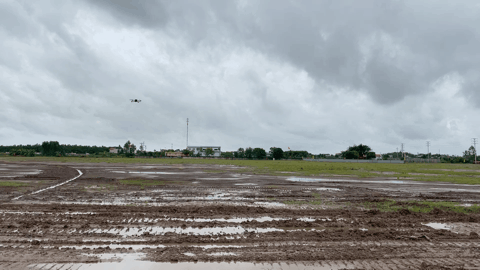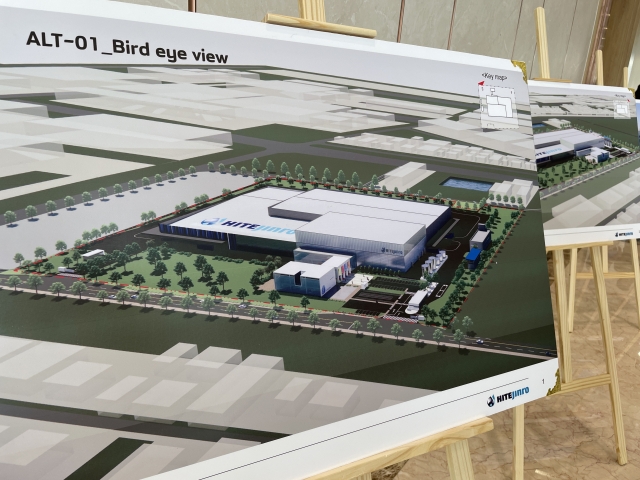Hite Jinro establishes its first overseas factory in Vietnam
Located in Thai Binh Province Green i-Park Industrial Zone
Emphasis on overseas standard factory and sustainable manufacturing environment
‘Clean Water’ purified through multiple stages… “Confident in water quality”,
![On the 10th, at the Green i-Park Industrial Zone in Thai Binh Province, Vietnam, Jung Sung-hoon, the head of Hite Jinro's Vietnamese subsidiary, is holding a press conference regarding the establishment of Hite Jinro's first overseas factory. [Provided by Hite Jinro]](https://imgnews.pstatic.net/image/016/2024/06/19/20240619050103_0_20240619090216795.jpg?type=w647)
On the 10th, at the Green i-Park Industrial Zone in Thai Binh Province, Vietnam, Jung Sung-hoon, the head of Hite Jinro’s Vietnamese subsidiary, is holding a press conference regarding the establishment of Hite Jinro’s first overseas factory. [Provided by Hite Jinro],
,
, ‘[Herald Economy (Thai Binh)=Reporter Jeon Saenal] “We plan to build a production factory in Vietnam to popularize Jinro. Once the factory is established, we will be able to produce at least 1 million boxes annually.” (Jung Sung-hoon, head of Hite Jinro’s Vietnamese subsidiary)’,
,
, ‘Thai Binh Province Green i-Park Industrial Zone. Located in northern Vietnam, Thai Binh Province is 110 km from the capital, Hanoi, taking about 2 hours by car. Hite Jinro’s first overseas production factory is being set up here in line with the “Global Vision 2030″ goal announced to commemorate Hite Jinro’s 100th anniversary. Hite Jinro has presented a blueprint to surpass 50 billion KRW in global soju sales by 2030 through the ‘popularization of Jinro.”,
,
, ‘The Hite Jinro Vietnam production company has previously signed a land lease contract for an industrial park with land and infrastructure worth 7.79 million dollars (approximately 104 billion KRW). The factory will be 11 times the size of a soccer field, covering an area of 82,083 square meters (approximately 25,000 pyeong). Preparation for establishment will continue until December of this year, and construction will begin in the first quarter of next year with plans to install production facilities. The expected completion date is 2026. Hite Jinro will start trial operations and production from the second quarter of 2026.’,
,
, ‘The initial goal is to produce 1 million boxes annually on a single fruit soju line. This accounts for 17% of this year’s overseas soju sales target. Jung, the head, explained, “We plan to adjust production volume according to demand,” and said, “We will export more than 80-90% of the production volume and supply 10-20% locally in Vietnam. We plan to initially establish one line for fruit soju on the site and plan to add 2-3 more lines in the future.”,
,
,

Hite Jinro factory site within Green i-Park Industrial Zone in Thai Binh Province, Vietnam. Reporter Jeon Saenal,
![Jung Sung-hoon, head of Hite Jinro's Vietnamese subsidiary, explaining future plans at the overseas factory site of Hite Jinro in Green i-Park Industrial Zone, Thai Binh Province, Vietnam. [Provided by Hite Jinro]](https://imgnews.pstatic.net/image/016/2024/06/19/20240619050105_0_20240619090216830.jpg?type=w647)
Jung Sung-hoon, head of Hite Jinro’s Vietnamese subsidiary, explaining future plans at the overseas factory site of Hite Jinro in Green i-Park Industrial Zone, Thai Binh Province, Vietnam. [Provided by Hite Jinro],
,
, ‘The establishment of the Vietnam factory is an investment considering the increasing export volume. In fact, over the past 6 years, Hite Jinro’s soju exports have increased by an average of 15% annually. According to the Financial Supervisory Service’s electronic disclosure system, Hite Jinro’s exports of soju amounted to 28.9 billion KRW in 2018, 29.8 billion KRW in 2019, 30.1 billion KRW in 2020, 28.1 billion KRW in 2021, 41.7 billion KRW in 2022, and 60.2 billion KRW in 2023.’,
,
, ‘Jung, the head, said, “We chose Thai Binh, which has the optimal location conditions in Vietnam, where the pro-business policy is being pursued.” He explained, “It is a city with excellent logistics access and abundant young labor.” He emphasized, “We will achieve mutual growth with Vietnam and Thai Binh Province.”‘,
,
, ‘Since being designated as an economic zone by the Vietnamese government, Thai Binh has rapidly grown into an industrial city. With a population of 2 million on an area of 1,586 km², which is about 2.6 times the size of Seoul. It has excellent accessibility with international airports, ports, coastal roads, etc. Many high school graduates and high university admission rates exist in Vietnam. There is also an abundance of vocational education workers. The proportion of productive age groups is as high as 57%.’,
,
, ‘In particular, Thai Binh Economic Zone is attracting companies with radical investment incentives. Corporate income tax is 100% exempt for the first 4 years after investment. Then, for the next 9 years, a 50% tax reduction benefit is provided. Even after 15 years of investment, there is a 10% preferential corporate tax for the remaining 2 years. Annual land lease fees (land tax) are exempt for 15 years as well.’,
,
,

Concept of Hite Jinro overseas factory within Green i-Park Industrial Zone, Thai Binh Province, Vietnam. Reporter Jeon Saenal,
,
, ‘The local factory’s goals presented by Hite Jinro are threefold. The first is ‘construction of overseas standard factory.’ Building a flexible production line in line with the globalization of soju and standardizing production based on localization. The second is ‘a space with a story.’ Plans to develop content infused with culture and history based on the heritage of Hite Jinro’s 100 years. The last is ‘creating a sustainable manufacturing environment.’ It aims to respond to carbon reduction with environmentally friendly design and promote stable and efficient operation.’,
,
, ‘Jung, the head, stated, “We designed the factory to be the most ideal from operations to production facilities, logistics systems, integrated monitoring systems, and quality management systems,” He said, “If we were to build additional factories domestically and internationally, we want to provide an efficient standard system that can be copied and pasted.”‘,
,
, ‘He expressed confidence even in concerns about the most important part of spirits, ‘water quality.’ “The water provided by the Green i-Park water treatment plant is called ‘Clean Water,’ which meets Korean tap water quality standards,” he said. “This water goes through a highly self-constructed water treatment facility to become even cleaner and safer.”‘,
,
, ‘Hite Jinro expects the Vietnam factory to become a forward base responsible for production and distribution in the Southeast Asian market. Jung, the head, emphasized, “We expect to be able to produce over 5 million boxes in the future, far exceeding the initial goal,” and said, “Expansion of facilities within Vietnam will take precedence over additional overseas factories.”‘,
,
,
![Promotional hall at Green i-Park in Thai Binh Province, Vietnam. [Provided by Hite Jinro]](https://imgnews.pstatic.net/image/016/2024/06/19/20240619050107_0_20240619090216840.jpg?type=w647)
Promotional hall at Green i-Park in Thai Binh Province, Vietnam. [Provided by Hite Jinro],

